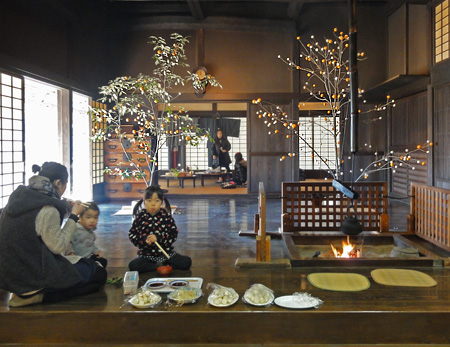予祝について

予祝について、予祝
2012年1月 9日 /里山民家だより
「よしゅく」と読みます。
どんな意味かと言えば、「あらかじめ祝う」という意味です。
これだけではまったく分からないと思います。
この「予祝」に「行事」をつけると「予祝行事」となります。
こっちの意味は、「主として小正月に、年間の農作業のしぐさを真似たり、木の枝に餅などをつけて実りを表したり、害獣を追うしぐさをしたりして、その一年間の豊穣(ほうじよう)を祝い願う行事。庭田植え・繭玉(まゆだま)・鳥追いなど。」とあります。
2012109-ma.jpg
つまり、「良いことが起こることを願って、先にお祝いをしてしまうこと」を予祝行事といいます。
先に祝ってしまう。良く考えてみるとすごい行事ですね。
前置きが長くなりました。今日は、里山民家で、予祝行事である「繭玉飾り」が行われました。
「繭玉飾り」は、餅を丸めて木の枝にさし、作物の豊作を祈念する飾り物です。かって養蚕が盛んだった関東では、蚕の豊作を願って飾られました。もちろん、里山民家のある狭山丘陵一帯では、養蚕や絹織物が主産業であったため、とても大切な行事でした。
今では、養蚕も織物もすたれ、繭玉飾りの習慣も薄れてきましたが、里山民家では、ボランティアが繭玉飾りを継承しています。里山民家の裏田んぼで収穫した米で繭団子を作り、裏山で切り出してきた木の枝にさしてこしらえた繭玉飾り。形だけではなく、心意気も今に繋げています。
予祝芸能(よしゅくげいのう)とは、伝統芸能を信仰の面からとらえたときの、萬歳や春駒など新春をことほぐ芸能や、農作業のあらましをあらかじめ一通り演じて順調に稲が実るように祈願する田遊び・御田などを指す。あらかじめ祝福することで、そのことの実現を祈るもので、その背景には言霊の信仰・思考法がある。獅子舞や風流踊りにおける「屋敷ぼめ」の歌などにも、同様の性格がみてとれる。予祝芸能に対し、災害を取り除く意味合いの強いものを除災芸能と呼ぶことがある。
予祝行事という,豊作を祈る行事
an event where a good harvest is prayed for, called a celebration in advance
さらに、田の神そのものではないが、それと深くかかわるものとしては、東日本に広く伝承されている小正月の鳥追い行事、かまくらなど水神の祭礼、どんど焼きをはじめとする左義長の行事、また、ナマハゲ・サイノカミ・トシドン・アマハゲなど日本各地に広がるトシノカミの訪問も予祝の性格をもつ民俗行事である。
In addition, the following events are also folk events having a characteristic of the preliminary celebration, although they do not directly involve Tanokami itself but have close relations with it: bird-driving events widely handed down in East Japan, festivals of God of Water and Rain such as a mid-January festival in northern Japan, snow huts in which children play house, a festival of Sagicho (ritual bonfire of New Year’s decorations) including the Dondo-yaki (a bonfire of the New Year’s decorations, such as pine branches, bamboos, and straw festoons, at a shrine around the 15th of January), visits of Toshinokami widely seen in regions across Japan such as namahage (folklore demons of the Oga Peninsula that pay frightening visits to children at the New Year), Sai-no-kami, Toshidon and Amahage.
予祝芸能(よしゅくげいのう)とは、伝統芸能を信仰の面からとらえたときの、萬歳や春駒など新春をことほぐ芸能や、農作業のあらましをあらかじめ一通り演じて順調に稲が実るように祈願する田遊び・御田などを指す。
In seeing the traditional perfuming arts from a religious point of view, Yoshuku Geino refers to various performing arts for celebrating the New Year such as Manzai (a traditional celebratory chant-like song) or Harukoma (a dance in which a performer carries a wooden horse’s head), and Ta asobi or Onda, a performance mimicking the processes of rice production to pray for a good harvest before farm work starts
秋田県横手市吉田の「雪中田植え」や青森県八戸市の「えんぶり」をはじめとする庭田植の行事も、予祝の性格をもつ民俗行事である。
Other folk events having a characteristic of the preliminary celebration include events of Niwataue (literally, rice planting in the garden) such as ‘Secchutaue (literally, race planting in snow)’ in Yoshida, Yokote City, Akita Prefecture and ‘Enburi (a rice planting dance named after a tool for rice field preparation)’ in Hachinohe City, Aomori Prefecture.
